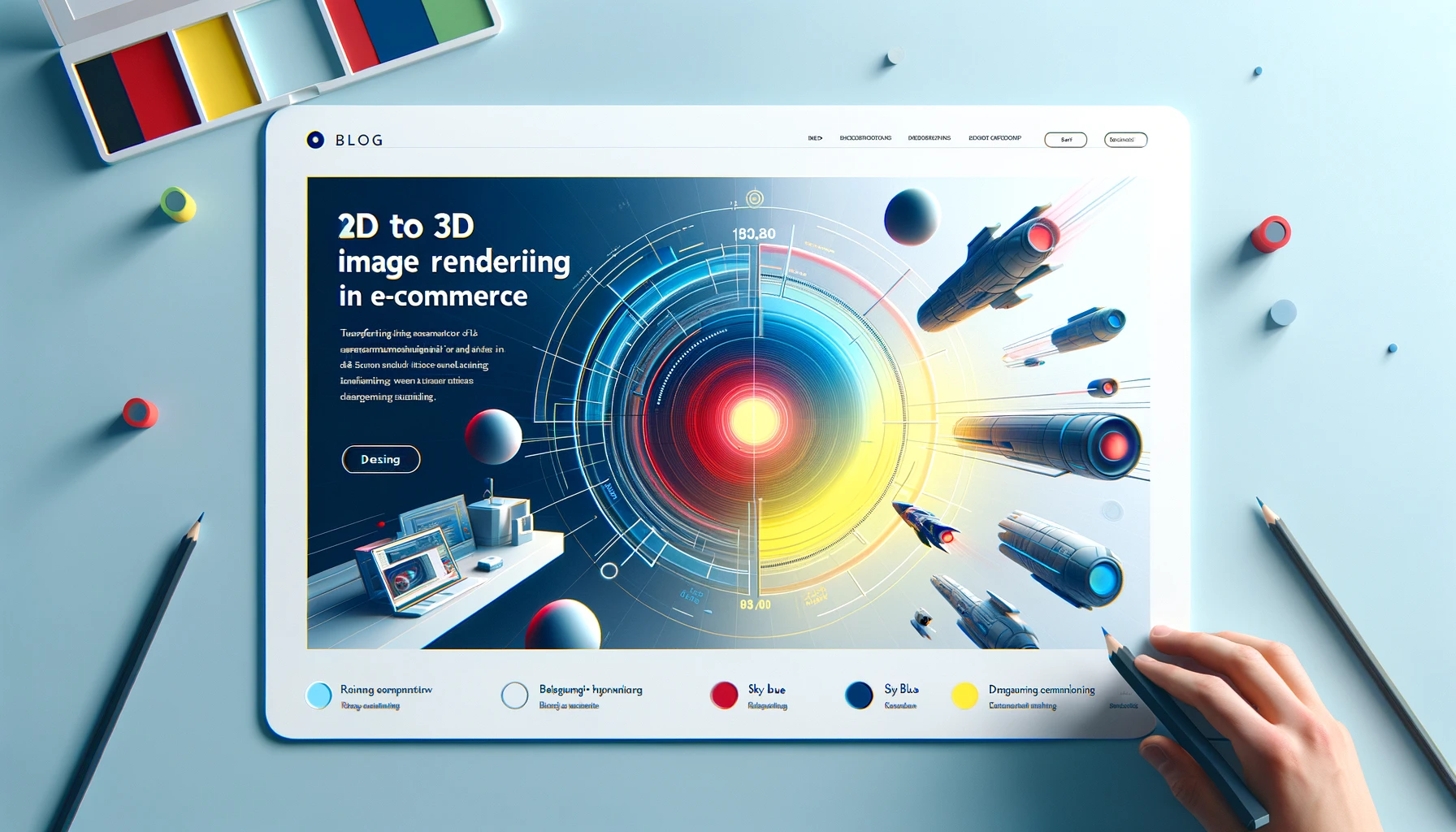Introduction
People’s buying experiences have been significantly impacted by shopping online. Individuals are getting used to it because it’s easy and convenient. It’s been predicted that by 2040, almost 95% of purchases will happen online. As more businesses start selling things online, it’s getting harder for them to stand out. They have to think of innovative ways to make sure people notice their products and services.
New technologies like animation and visualization are helping them show off their products in a way that’s different and interesting. One popular way is making 3D models of products. These 3D models can help sell more things, make fewer people return stuff, and make shopping online more fun. Many online stores use 3D rendering to make their products look better and more realistic. This article is about 3D image rendering, what is a 3D-rendered image, and how businesses can use it with the help of Rubick.ai.
What Is a 3D Rendered Image?
A 3D-rendered image is a blend of technology and artistic skill. It is essentially a flat, visually appealing picture created from a three-dimensional model using computer graphics cards and specialized software. Digital artists and graphic designers use a process called 3D image rendering when making these images. This process transforms the complex information within a three-dimensional structure into a visually striking 2D image. This transformation is crucial for allowing viewers to notice the details of the products on flat surfaces, such as TV screens, computer monitors, or sheets of paper.
The importance of 3D-rendered images goes beyond static representations. While static images are used in posters, ad banners, and various print materials, these digital creations can also be animated. These find applications in advertisements, e-commerce, short clips, and even films. Rubick.ai is a solution that can help your online business. With its 3D image rendering AI tool, you can turn plain 2D images into amazing 3D models, giving your customers an amazing experience as they explore and interact with virtual products.
What Is 3D Image Rendering?
3D image rendering, a computer graphics process, transforms three-dimensional data and models into lifelike realistic images. It’s a form of virtual photography where staging and lighting play crucial roles in crafting the final visual masterpiece. The process involves utilizing 3D data and images to generate a 2D image that captures a photorealistic essence. The more accurate the calculations in scanning materials, polygons, textures, and lighting, the higher the rendering quality.
People can sense their surroundings, and unrendered 3D models lack the realism necessary to engage viewers effectively. Even the most detailed 3D models fall short without the right rendering process, which adds elements such as perspective, lighting, shadows, and subtle movements. The rendering process brings scenes to life by incorporating reflections, environmental effects, and minute movements, making the visuals more authentic and appealing to the human eye.
These services are popular for their flexibility, cost-effectiveness, and ability to produce realistic images for various applications, from print to digital media. 3D image rendering makes products more attractive to potential buyers. Designers can make virtual product models that users can view and change angles to see all the details. Customers get a clearer idea of products through detailed 3D images, reducing returns because of not meeting expectations. Businesses using 3D rendering have an edge by offering an engaging shopping experience.
Types of 3D Image Rendering
Two primary types of 3D image rendering are widely used:
- Real-time Rendering: It focuses on the instant analysis of images seen in hyper-interactive user interfaces of software or video games. For optimal real-time rendering, the software must render an image in less than 1/30 of a second. This type of rendering excels in creating realism within interactive environments, providing a dynamic and engaging user experience.
- Non-real-time Rendering: It is best for animations and digital media without user interaction. Unlike real-time rendering, no inputs or actions are coming from viewers, allowing for higher rendering quality. However, this is more expensive and demands extensive technical expertise. This method is ideal for creating visually stunning scenes where the focus is on meticulous details.
Best Practices of 3D Image Rendering for E-commerce
Perfecting the art of 3D image rendering involves adopting effective techniques that enhance the realism and quality of your models. Let’s explore best practices to improve the results:
1. Keep the Mesh Clean for Easy Modeling
A crucial aspect of 3D image rendering is maintaining a clean and low-poly mesh. This not only simplifies the modeling process but also ensures adaptability to various scenarios. A well-organized polygon mesh facilitates work on intricate 3D models, making the rendering process more manageable.
2. Use HDRI Sensibly for Lighting Enhancement
High Dynamic Image Ranging (HDRI) proves to be a valuable tool in rendering and accentuating lighting backgrounds by blending multiple images across different exposures. To achieve optimal results, opt for a 32-bit HDRI with high resolution, providing detailed light information for the entire 3D scene. This enhances contrast and reflections along the curvature of your model.
3. Gather Reference Materials
When modeling an existing object, collecting an ample amount of reference materials is essential. This practice contributes to accuracy and realism, providing valuable data such as top, front, and side views to maintain precise proportions. The use of reference materials ensures that your 3D model aligns closely with the real-world object you are replicating.
4. Consider Composition for Engaging Renders
Achieving a perfect composition in 3D rendering involves balancing individual elements to form a cohesive whole. Employ focal points and guidelines to guide viewers through different planes of the rendered scene. Attention to detail, like the color palette and camera movements, enhances the overall environment, making it visually pleasing.
5. Bevel Every Edge for Realism
Beveling edges and corners of a 3D model contribute to realism and natural light reflection. Subtle beveling softens the edges, mimicking real-world objects where sharp edges are uncommon. This technique enhances the overall quality of your rendered model, adding a level of realism crucial for a compelling 3D image rendering.
Things to Avoid in 3D Image Rendering
In the process of 3D image rendering, there are certain challenges that you should be mindful of to ensure high-quality and visually appealing renders.
1. Insufficient Data Collection
To achieve optimal results, it is necessary to request detailed materials such as rough sketches, drawings, blueprints, and other relevant visuals from the client. Additionally, crucial information like plans, exact proportions, high-definition images of the product from various angles, the intended purpose of the model, and its usage context should be obtained before commencing the rendering process.
2. Inadequate RAM Capacity
The rendering speed and quality can be significantly compromised if the computer’s RAM capacity is insufficient. High-end rendering programs demand ample RAM for a seamless process, making it essential to work with a minimum of 32GB or higher. Essentially, superior RAM not only enhances rendering speed but also contributes to the overall quality of the final output. Therefore, prioritizing a sufficient RAM capacity is crucial for any 3D renderer seeking optimal performance.
3. Underestimating Graphics Card Importance
The effectiveness of the latest 3D rendering software heavily depends on the computer’s Graphics Processing Unit (GPU), which is designed to handle graphics and critical calculations. A low-performance or outdated GPU can affect the rendering process. Investing in a high-end GPU becomes a top priority to ensure smooth and efficient rendering.
4. Oversimplifying Designs
Some rendering artists may unintentionally create overly simplistic designs, lacking realism and the grandeur associated with 3D rendering. Both beginners and seasoned professionals must exercise an artistic eye to avoid this common mistake. While adding intricate details can rectify the issue, preventing such errors is advisable.
5. Neglecting Texture Quality
Overlooking or disregarding texture quality is a significant blunder that can diminish the impact of 3D renders. Texture quality adds a human touch to the render, capturing real-life nuances that impress clients. High-definition textures, with natural shine, creases, and folds, contribute to a life-like appearance. Irrespective of the rendering quality, texture quality can make the end product seem plastic and artificial.
Conclusion
E-commerce marketers who want to differentiate their products from other sellers find 3D image rendering to be an invaluable marketing and promotional tool. Furthermore, possible shortcomings in design may be found early on using 3D models and prototypes.
In online selling, being ahead is crucial. Rubick.ai gives your business an advantage by turning regular product visuals into 3D representations. This not only grabs attention but also sets your products apart from others, making customers more engaged. The AI-driven rendering ensures that every detail is highlighted, making the products look almost real and appealing. Visit Rubick.ai to book a demo session and discover the capabilities of the 3D image rendering tool.


